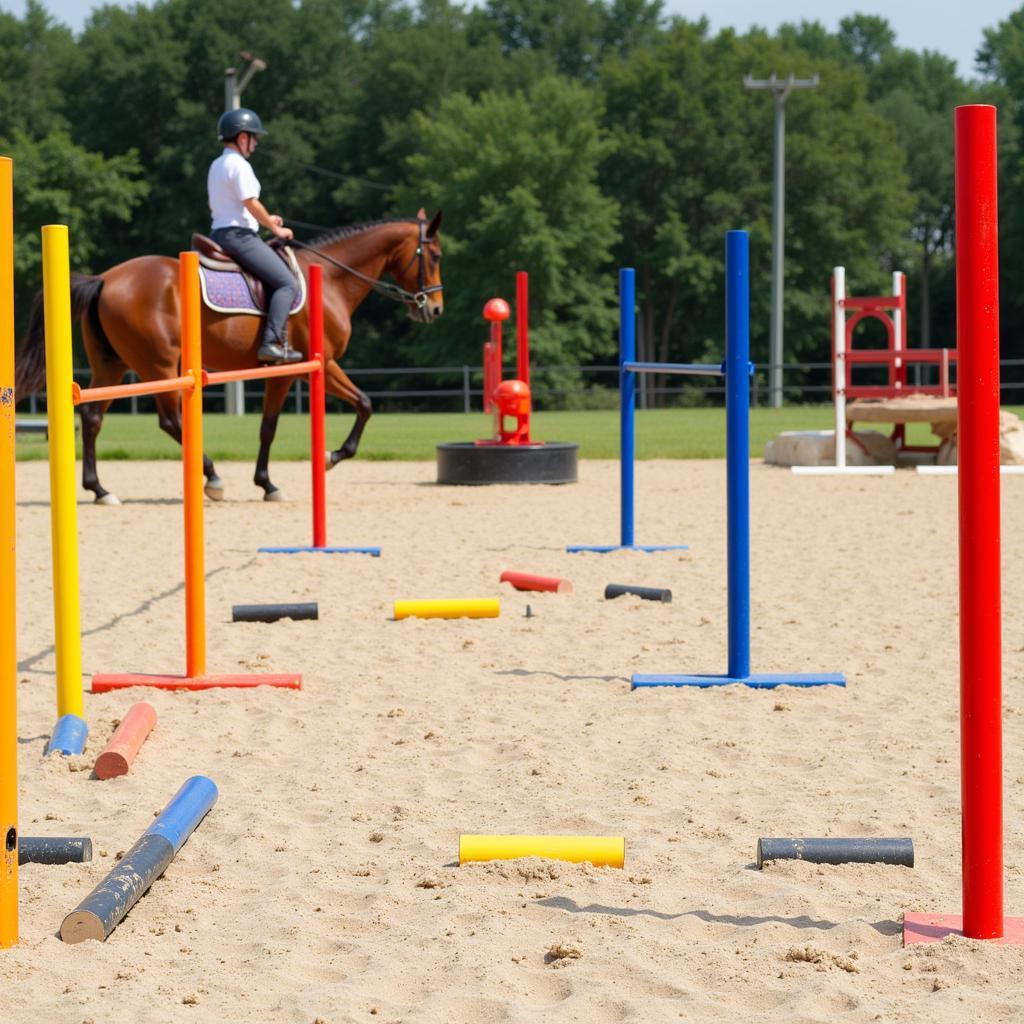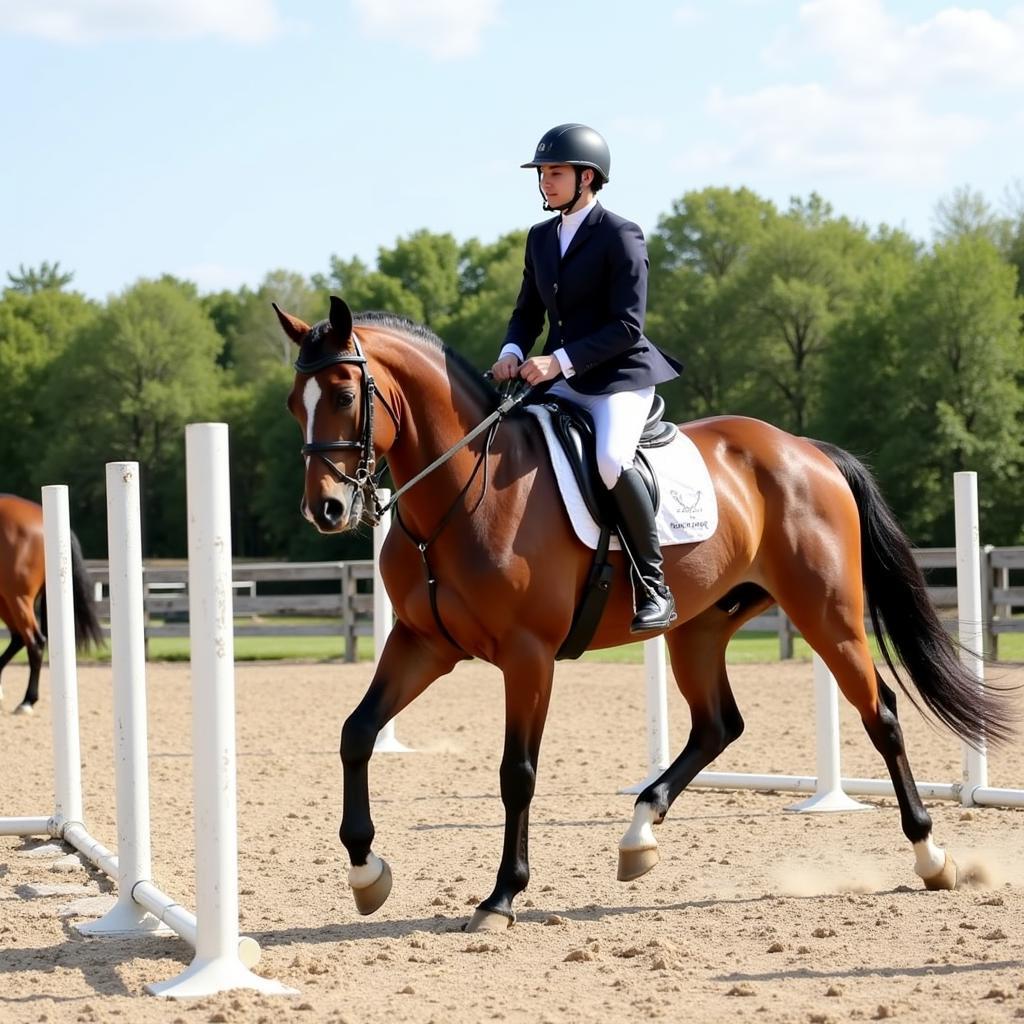Horse Poles, simple as they seem, are powerful tools for training and enriching the lives of horses of all disciplines. Whether you’re a seasoned equestrian or just starting out, understanding the benefits and uses of horse poles can dramatically impact your horse’s progress and enjoyment of work. From improving footwork to building confidence, horse poles offer a versatile and effective approach to training.
 Horse Poles in a Training Arena
Horse Poles in a Training Arena
Why Use Horse Poles?
Think of horse poles as gymnastic equipment for your equine partner. They encourage your horse to become more aware of their body, improving balance, coordination, and flexibility. Here’s a closer look at the benefits:
- Enhanced Footwork: Navigating poles requires horses to pick up their feet carefully, improving their overall footwork precision.
- Increased Muscle Engagement: The act of stepping over poles engages a variety of muscle groups, promoting strength and development, particularly in the core, back, and hindquarters.
- Improved Rhythm and Balance: Working with poles encourages the horse to find a consistent rhythm and maintain balance, essential for smooth transitions and more advanced maneuvers.
- Mental Stimulation: Pole work provides a welcome change from routine training, engaging your horse mentally and preventing boredom.
- Confidence Building: Successfully navigating poles, especially when new challenges are introduced gradually, builds your horse’s confidence and trust in both themselves and their handler.
Getting Started with Horse Poles
Introducing your horse to poles should be a gradual and positive experience.
Choosing the Right Poles:
Horse poles come in various materials, including wood, PVC, and even foam. Ground poles for horses are a popular choice for beginners as they’re lightweight and easy to move.
Setting Up Your Poles:
Start with a few poles laid flat on the ground in a straight line. Gradually increase the number of poles and the complexity of the configurations as your horse progresses.
 Horse and Rider Navigating Poles
Horse and Rider Navigating Poles
Introducing Your Horse to Poles:
- Lead your horse over the poles: Begin by leading your horse over the poles at a walk, allowing them to acclimate to the new obstacles.
- Introduce riding over poles: Once your horse is comfortable walking over the poles, begin riding over them at a walk, maintaining a steady and relaxed posture.
- Gradually increase the challenge: As your horse gains confidence, you can start raising the poles, changing the distances between them, and creating different patterns.
Creating Engaging Pole Work Exercises
The beauty of horse poles lies in their versatility. Here are a few exercises to get you started:
- Basic Lines: Start with a straight line of poles, gradually increasing the number as your horse becomes more confident.
- Raised Poles: Introduce raised poles to encourage greater muscle engagement and improve your horse’s technique.
- Circles: Incorporate poles into circle work to encourage bending and flexibility.
- Serpentines: Practice serpentines over poles to enhance your horse’s balance and responsiveness to your aids.
For a fun and challenging showmanship pattern incorporating poles, check out these 4 H horse showmanship patterns.
Safety Considerations
While horse poles are generally safe, keep the following tips in mind:
- Start Slowly: Always introduce poles gradually, allowing your horse to build confidence at their own pace.
- Supervise Carefully: Always supervise your horse when they are around poles, especially during the initial introduction.
- Maintain Control: Ensure you maintain control of your horse’s speed and direction when working with poles.
- Listen to Your Horse: Pay attention to your horse’s body language. If they show signs of stress or anxiety, stop and reassess your approach.
Conclusion
Horse poles are an invaluable tool for enhancing your horse’s physical and mental well-being. By incorporating pole work into your training routine, you can improve their footwork, balance, and confidence, creating a more enjoyable and rewarding experience for both you and your equine partner. Remember, patience and consistency are key, and always prioritize your horse’s safety and well-being.
FAQs
1. How often should I use horse poles in my horse’s training?
Incorporating pole work 1-2 times a week can be beneficial. However, always consider your horse’s fitness level and avoid overworking them.
2. Can horse poles help with horses that bounce horses?
Yes, pole work can help improve a horse’s balance and coordination, which can be beneficial for horses that tend to rush or bounce.
3. What is the ideal height for raised poles?
The ideal height depends on your horse’s experience and size. Start with a low height and gradually increase it as your horse progresses.
4. Can I use horse poles for other animals besides horses?
Yes, horse poles can be used for training other animals, such as dogs, for agility and obedience exercises.
5. What are some creative pole work exercises for more advanced horses?
Advanced exercises include combinations of raised poles, fan patterns, and even small jumps incorporated into the pole work.
Need more information or assistance with your horse’s training? Contact us at Phone Number: 0772127271, Email: [email protected], or visit us at QGM2+WX2, Vị Trung, Vị Thuỷ, Hậu Giang, Việt Nam. Our dedicated customer support team is available 24/7.